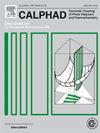考虑到沉淀物内部扩散的沉淀动力学新模型
IF 1.9
3区 材料科学
Q4 CHEMISTRY, PHYSICAL
Calphad-computer Coupling of Phase Diagrams and Thermochemistry
Pub Date : 2024-11-01
DOI:10.1016/j.calphad.2024.102764
引用次数: 0
摘要
沉淀动力学定量建模可在计算材料设计框架中发挥重要作用。对于许多材料体系,例如铁-铜体系,沉淀物(平衡时富含铜)的成核成分与平衡成分相去甚远。这反过来又会影响沉淀动力学,因此建立铜沉淀物成分演变模型的能力非常重要。在本研究中,我们提出了一种在朗格-施瓦茨-坎普曼-瓦格纳沉淀建模框架中实施的新方法,即用一个显式函数定义沉淀物内部的浓度分布,并同时求解沉淀物和基体中的扩散通量,以计算沉淀物的增长率。根据原子探针层析成像法对 15-5 PH 不锈钢中的铜析出结果对新模型进行了评估。对扩散系数和界面能的影响进行了参数研究,得出的结论是新模型能够描述实验测定的铜沉淀体积分数、平均半径、数量密度和成分的演变。本文章由计算机程序翻译,如有差异,请以英文原文为准。
A new model for precipitation kinetics considering diffusion within the precipitates
Quantitative modelling of precipitation kinetics can play an important role in a computational materials design framework. For many material systems, e.g., the Fe-Cu system, the precipitates (rich in Cu at equilibrium) nucleate at a composition far away from the equilibrium. This in turn affects the precipitation kinetics, and the capability to model the compositional evolution of the Cu precipitates is therefore important. In the present work we propose a new approach implemented in a Langer-Schwartz-Kampmann-Wagner precipitation modelling framework where the concentration profile inside the precipitates is defined with an explicit function and the diffusive fluxes in both precipitates and matrix are solved concurrently to compute the growth rate of the precipitates. The new model is evaluated with respect to results from atom probe tomography for Cu precipitation in a 15–5 PH stainless steel. A parameter study of the effect of diffusion coefficients and interfacial energies is conducted, and it is concluded that the new model is capable of describing the experimentally determined evolution of the Cu precipitate volume fraction, mean radius, number density and composition.
求助全文
通过发布文献求助,成功后即可免费获取论文全文。
去求助
来源期刊
CiteScore
4.00
自引率
16.70%
发文量
94
审稿时长
2.5 months
期刊介绍:
The design of industrial processes requires reliable thermodynamic data. CALPHAD (Computer Coupling of Phase Diagrams and Thermochemistry) aims to promote computational thermodynamics through development of models to represent thermodynamic properties for various phases which permit prediction of properties of multicomponent systems from those of binary and ternary subsystems, critical assessment of data and their incorporation into self-consistent databases, development of software to optimize and derive thermodynamic parameters and the development and use of databanks for calculations to improve understanding of various industrial and technological processes. This work is disseminated through the CALPHAD journal and its annual conference.

 求助内容:
求助内容: 应助结果提醒方式:
应助结果提醒方式:


